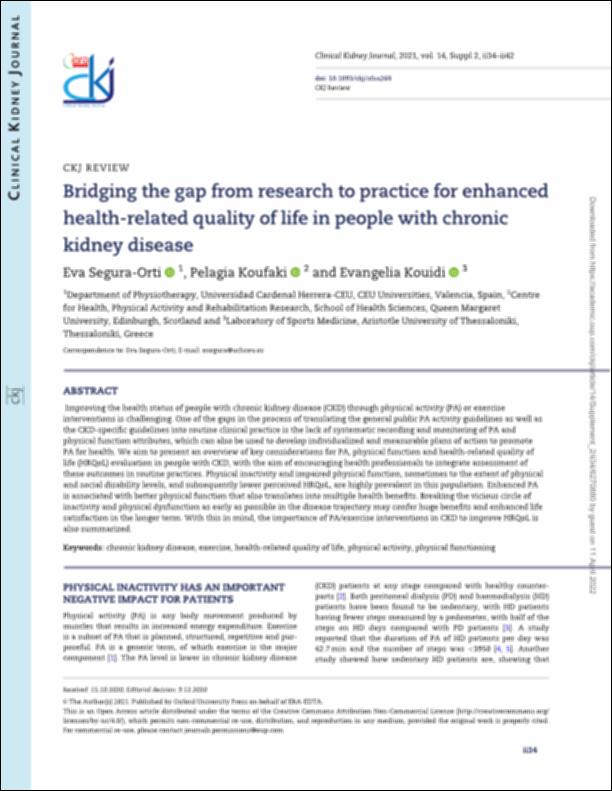Please use this identifier to cite or link to this item:
http://hdl.handle.net/10637/13640Bridging the gap from research to practice for enhanced health-related quality of life in people with chronic kidney disease
| Title: | Bridging the gap from research to practice for enhanced health-related quality of life in people with chronic kidney disease |
| Authors : | Segura Ortí, Eva Koufaki, Pelagia Kouidi, Evangelia |
| Keywords: | Ejercicio físico - Uso terapéutico.; Chronic renal failure - Patients - Quality of life.; Kidneys - Diseases - Physical theraphy.; Insuficiencia renal crónica - Pacientes - Calidad de vida.; Exercise - Therapeutic use.; Insuficiencia renal crónica - Fisioterapia.; Chronic renal failure - Physical therapy.; Riñones - Enfermedades - Fisioterapia. |
| Publisher: | Oxford University Press European Renal Association |
| Citation: | Segura-Orti, E., Koufaki, P. & Kouidi, E. (2021). Bridging the gap from research to practice for enhanced health-related quality of life in people with chronic kidney disease. Clinical Kidney Journal, vol. 14, Suppl 2 (01 apr.), pp. ii34–ii42. DOI: https://doi.org/10.1093/ckj/sfaa268 |
| Abstract: | Improving the health status of people with chronic kidney disease (CKD) through physical activity (PA) or exercise interventions is challenging. One of the gaps in the process of translating the general public PA activity guidelines as well as the CKD-specific guidelines into routine clinical practice is the lack of systematic recording and monitoring of PA and physical function attributes, which can also be used to develop individualized and measurable plans of action to promote PA for health. We aim to present an overview of key considerations for PA, physical function and health-related quality of life (HRQoL) evaluation in people with CKD, with the aim of encouraging health professionals to integrate assessment of these outcomes in routine practices. Physical inactivity and impaired physical function, sometimes to the extent of physical and social disability levels, and subsequently lower perceived HRQoL, are highly prevalent in this population. Enhanced PA is associated with better physical function that also translates into multiple health benefits. Breaking the vicious circle of inactivity and physical dysfunction as early as possible in the disease trajectory may confer huge benefits and enhanced life satisfaction in the longer term. With this in mind, the importance of PA/exercise interventions in CKD to improve HRQoL is also summarized. |
| Description: | Este artículo se encuentra disponible en la siguiente URL: https://academic.oup.com/ckj/article/14/Supplement_2/ii34/6270880 |
| URI: | http://hdl.handle.net/10637/13640 |
| Rights : | http://creativecommons.org/licenses/by-nc/4.0/deed.es |
| ISSN: | 2048-8505 2048-8513 (Electrónico) |
| Issue Date: | 1-Apr-2021 |
| Center : | Universidad Cardenal Herrera-CEU |
| Appears in Collections: | Dpto. Enfermería y Fisioterapia |
Items in DSpace are protected by copyright, with all rights reserved, unless otherwise indicated.


